The sick chicken symptom checker.
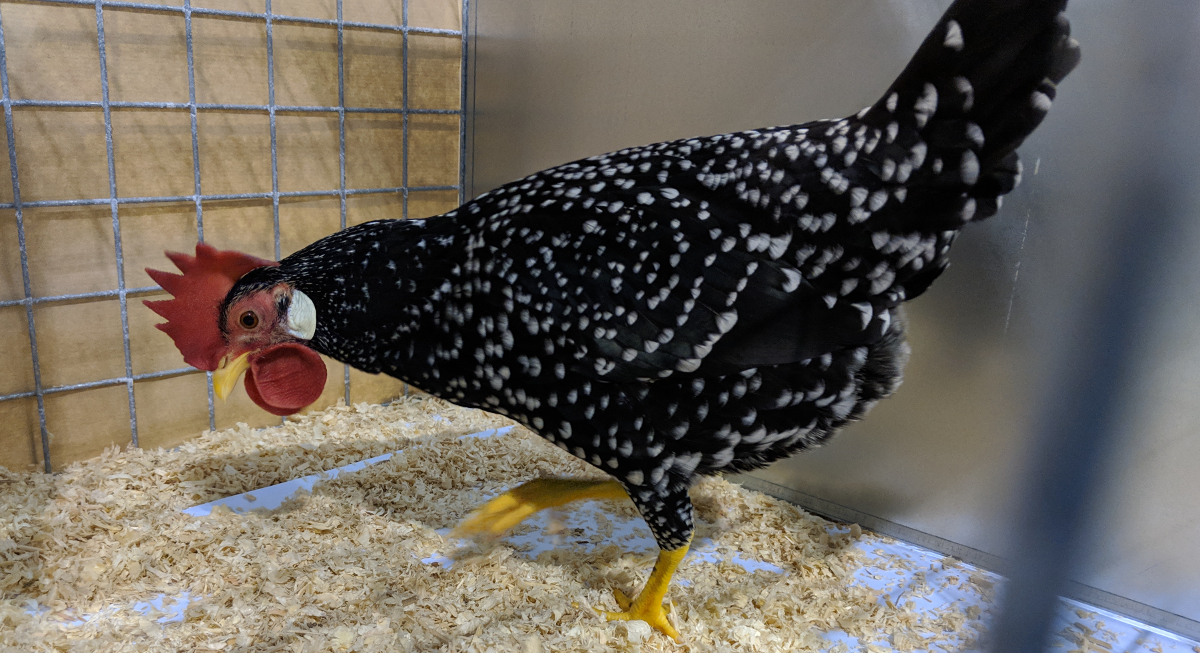
Whats wrong with my chicken?
Chickens are for the most part healthy and most live a long happy life with no ailments at all especially with good husbandry and practices. A modern vaccinated hybrid will generally lay eggs quite happily for 3 or 4 years and may live a few years after and heritage breeds may live quite a bit longer.
It is possible that from time to time you may be faced with a sick or injured chicken. I have had lots of chicken for a great many years and have seen quite a few things in that time. Some diseases like Newcastle and Avian flu are notifiable which means you have to inform the local authorities if you suspect them.
Is one or more of your flock displaying some odd behaviours? Can you see some tell-tale signs of illness, such as a bubbly eyes, sneezing or droopy wings or just general lethargy. Your chicken may be feeling a bit under the weather, and might need your assistance to help their health get back on track.
If after using this guide you are still not sure what is wrong with your chicken or it is very ill please consult a vet.
What does a healthy chicken look like?
A healthy chicken will be active and wandering around looking everywhere it can for interesting morsels of food.
Healthy birds will have bright clear eyes, well groomed glossy feathers and a easy gait. In addition bright red combs and a clean bottom.
Below: A healthy chicken.
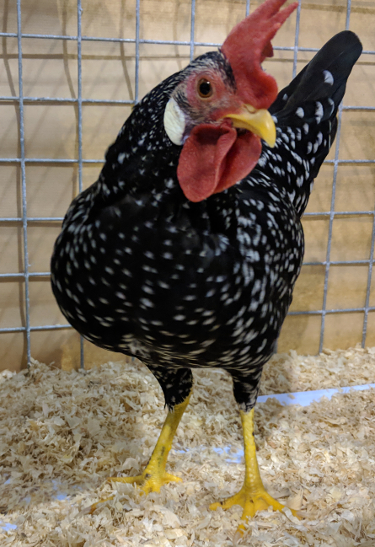
The chicken keepers symptom checker:
The first thing a backyard keeper often notices is that one of their birds is either stood out on it's own away from the others, hunched over or fluffed up. Any one of these three symptoms is an excellent marker that something is amiss.
Below: An unwell chicken. This settled flat to the floor lethargy with drooping head is common in sick chickens.
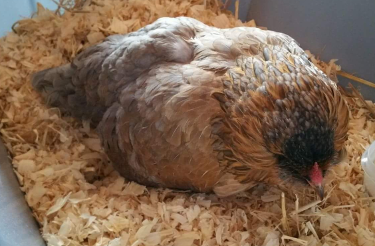
If you think you have an unwell chicken the first thing to do is approach it and see if it moves off. It may just be having a snooze.
Things to take a note of:
Is it a very hot or cold day? Heat can effect chickens quite badly especially if they can't get into the shade and the cold will cause them to fluff their feathers.
Is it the only sick bird? The diseases can be different if three or four chickens are affected in your flock.
The time of the year is important. Birds are more likely to be sick towards the end of Autumn or the Fall when the stress of the moult is combined with shortening days and colder wetter conditions.
Catch and examine the bird. A healthy chicken will be difficult to catch but a sick bird will just allow herself to be picked up. Check over for physical injury and the chicken can still walk is it moving smoothly or limping.
Take a look at the comb. It should be bright, red and plump although it may be pale in a young hen that has yet to start laying.
Is the comb:
1. Pink. This is normal for a young pullet but may signify anaemia (shortage of red blood cells) in a mature bird.
Below: The normal comb of a young pullet yet to develop the deep red of a laying hen.
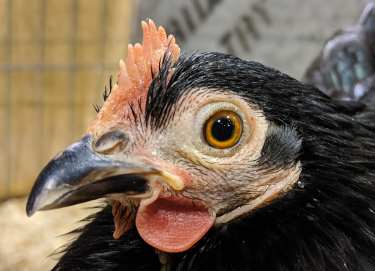
2. Pale. Sign of illness or blood loss.
Below: Very pale combs can be a sign of internal bleeding or parasite overload.
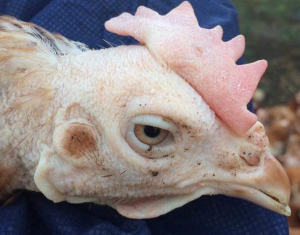
3. Purple. Also called cyanosis and means there is not enough oxygen in blood indicating heart or respiratory disease.
Below: This rooster has a deep purple colour to his comb indicating cyanosis.
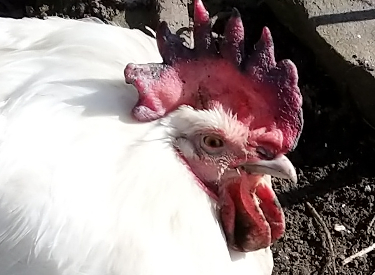
4. Black. Skin colour of some types. If the tips are affected then frostbite.
5. Scabby. Healing wounds from bullying, clear up within a week or so. Northern fowl mite bites which may seep for a day or so and then clear up but re-appear each time the bird is bitten. Fowl pox produces black scabs that last weeks.
Below: wound inflicted by bullying or feather pecking.
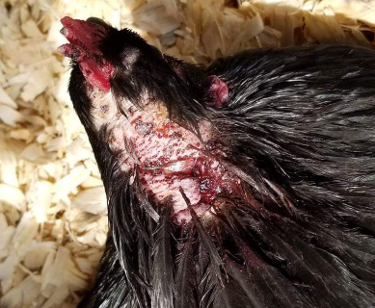
6. Small. Normal for young pullet and some types of hen.
Below: This Sebright hen has a very small comb but it is completely normal.
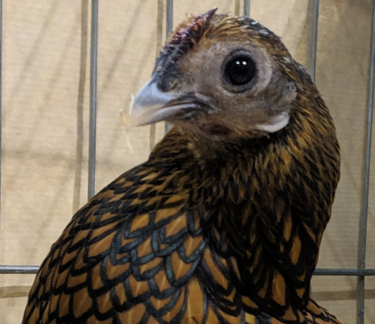
7. Orange. Lack of sunlight or beta carotene overdose.
Below: A show-bird exhibiting an Orange comb.
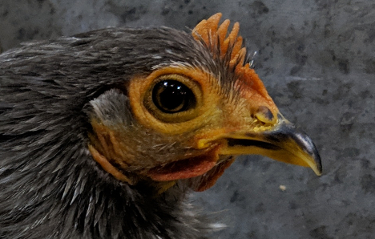
This is caused either because show chickens are often fed diets rich in supplemented nutrients and beta carotene show up as orange in the skin or because the bird has been raised indoors for showing and not got enough sunshine.
Is the crop:
The crop is a muscular storage pouch where food is moistened before being released into the digestive system in a regular fashion. If the crop is -
1. Empty. So if the chicken is not eating which may be bullying, illness, blocked digestive system, poisoning or virus.
2. Full and mushy. Feeling a bit like a water balloon. This is sour crop.
3. Hard solid lump. Most likely impacted crop. Most likely caused by to much fibrous greens or water after dry layer pellets/feed.
Crop issues are common in rescued battery hens and much less so in heritage types.
Also the more varied the diet the less likely the chicken is to develop crop problems.
Free range chickens with access to grit and stones are the least likely to suffer from crop issues.
Full article on the crop, it's problems and the treatments.
Face and head:
Swollen face could be insect bites or stings or poisonous or stinging plants.
Is the chicken coughing, wheezing or gaping or gasping for breath.
Head shaking may be respiratory diseases or parasites. All chickens will shake their heads from time to time so it is how often it happens that is important.
Sneezing or wheezy chest are most probably respiratory infection or gape worm. All chickens will sneeze occasionally.
Infectious Coryza is sometimes called the swollen head disease.
Eyes:
1. Swollen eyes in chickens can be a foreign body like a grass seed or an infection.
2. Closed eyes are normal if the bird is asleep and they do doze periodically during the day. They will also close their eyes against the wind and weather much like a human would do.
Below: MG often starts as bubbles in the eyes.
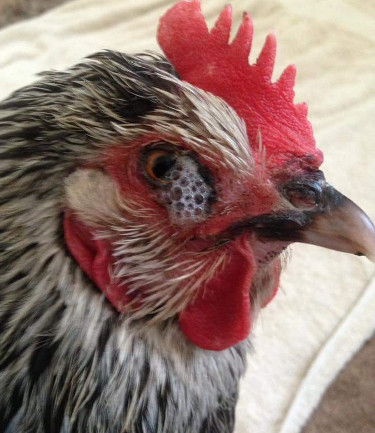
If they are shut for long periods this is general sign of illness so look for other symptoms. MG (Mycoplasma gallisepticum) can cause eyes to seal shut after a period of bubbles in the eye.
3. Bleeding is common after cockerels have been fighting and their eyes swell up so they can't see but predators can cause this as well. If an eyeball is missing then see a vet immediately.
Droppings:
Normal chicken droppings vary enormously, depending on the time of day, what the chicken has been eating and and drinking and whether or not she is broody. Normal chicken poop is firm and brown with white crystals in varying amounts. It can look greyish and is able to hold it's shape.
Chickens go between 12 and 20 times a day. Any yellow foamy droppings or bloody droppings are abnormal.
The first place to look for abnormal droppings is under the roosts in the morning as hens will void waste during the night.
Abnormal signs in the droppings include:
1. Blood in droppings. Could be Coccidiosis, pecking damage to the vent, a burst blood vessel during egg laying or worms.
Coccidiosis treatment is amprolium — sold under the brand name Corid in the US and Coxoid in the UK.
Buy it on Amazon.com - Corid 20% powder 10oz and add to the water for the whole flock for 4 to 7 days or buy Harkers Coxoid on Amazon.co.uk.
2. Mucus or lining. You may find a dropping with small amounts of red tissue and it looks alarming. In small amounts it is normal and is just your hen shedding intestinal lining that constantly regenerates. Large amounts of blood or tissues are not normal and should be investigated further, could be Coccidiosis, parasites or infection.
3. Diarrhoea. There is a normal smelly brown chicken poo that is very runny. this is Cecal poop and can be anything from mustard to dark brown in colour and is produced once every eight to ten droppings. Cecal poop is generally thicker and stickier than normal poop and lacks the white crystal cap. They have a particularly foul smell and the darker the poo the more obscene the smell. Unpleasant as it is, cecal poo is produced by fermentation and is a good indication that the digestive tract is working properly.
Causes and treatment of dirty vents in chickens.
Other causes are diet, normally too much protein, worms, Coccidiosis, intestinal infection, food poisoning or old out of date feed or contaminated water.
4. Worms. Treat all chickens like they have intestinal worms and parasites and treat for worms on a regular basis.
Worms are treated with regular deworming products like Fleming in the US and Flubenvet in the UK.
Buy Fleming 17% dewormers 80z from Amazon US or Flubenvet from Amazon uk (requires questionnaire and prescription).
5. Bright green coloured discolouration. If your hens free-range and have a diet high in grass, weeds and leafy green treats, you may find that green poop is quite normal for your flock. It could also be kidney failure
6. If the yolk is discoloured it could be a few things, highly coloured foods like beetroot or the red coloured fishing maggots can make the yolks look bloody and it could be egg peritonitis.
7. Bad smell is normally a sign of Mycoplasma gallisepticum (MG) or other bacterial infection. The treatment may require a trip to the vet for a prescription but is normally 5 days on Tylan or a similar antibiotic.
8. Black droppings could be the result of eating dark purple foods such as blackberries or elderberries. It could also be dried blood in the digestive system which is serious enough for a vet.
9. Chickens will drink more in hot weather and droppings will be runnier
10. Broody Poop is massive and has a particular odour all of its own!
Eggs:
Eggs and sometimes the lack of them is diagnostic.
Straining or trying to lay . Either the hens first egg or it may be egg bound or suffering from egg peritonitis. If it is the hens first time the egg will appear in good time. The other two causes need immediate treatment and
Wrinkled shells normally means an infection. It can happen when a hen is disturbed overnight by predators or a thunderstorm. If it is a one off you need not worry, if it persists then diagnosis and treatment is required.
Below: A wrinkled egg:
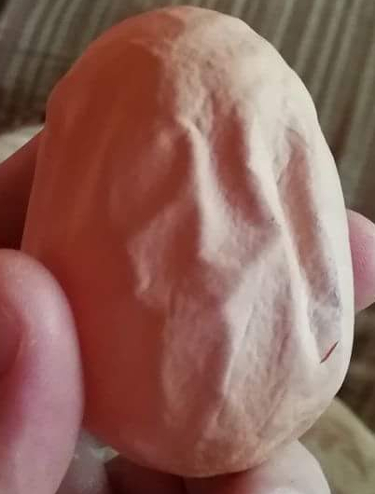
Thin shells are common in older hens or those with a lack of calcium in the diet.
Fewer eggs. A drop in production happens mostly in older hens but it can also means hens are malnourished or have just been broody. For a full explanation of drops in egg production see this article.
Stopped laying eggs completely. Older hens will stop completely otherwise it may be the moult or illness. Parasites can suck enough blood and fluids from a chicken to effect egg production.
Powdery shells are common in older, stressed hens with a lack of calcium in the diet.
Calcium balls on shells mean there is too much calcium in the diet. It is most likely when the hen starts laying in the spring and will normally pass in a few days as the cycle settle down. It is never harmful to the chicken and nothing to worry about at all.
Blood spots are less common in white and light egg layers and in free-range hens and those on pasture. The eggs are fine to eat and you can just remove the bit you don't like.
Watery eggs are common in older hens. This is the reason commercial layers are slaughtered at 80 weeks or so. Backyard hybrids may take longer to show this and heritage breeds may never get watery eggs.
Egg Peritonitis is when the peritoneum or lining of the egg tube becomes inflamed due to an infection from bacteria. It can produce lash eggs which are very unpleasant.
Requires antibiotics like Tylan prescribed by a Vet.
Below: An example of a lash egg, they do take many forms.
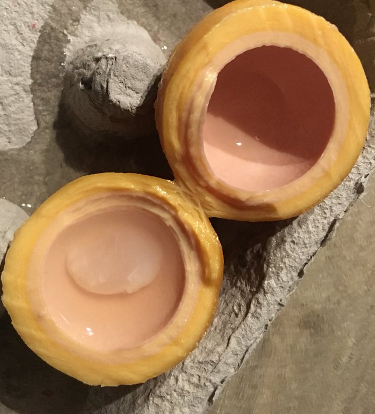
See the detailed article - why has my chicken stopped laying eggs? or 37 egg and shell problems.
Feathers:
Bald patches or missing feathers. Feather pecking, amorous cockerels can rub the feathers of a hens back. Moulting, normally Autumn or the fall but it can be anytime. Mites, Parasites or Mange.
Fluffed up. This is a general sign of illness if hen is hunched up unless she is unwilling to leave a nest box then she is most likely broody.
Scratching. Quite common during the moult as old feathers fall out and new ones growing can be annoying. Otherwise fleas, lice or mites.
Chickens staying out at night or laying away from the coop might mean mites or parasites in the coop or nest boxes.
For a detailed moulting guide for chickens.
Legs, Wings and joints:
Lameness might be an injury, Mareks Disease or Bumble foot.
Below: Classic Bumble foot in chickens.
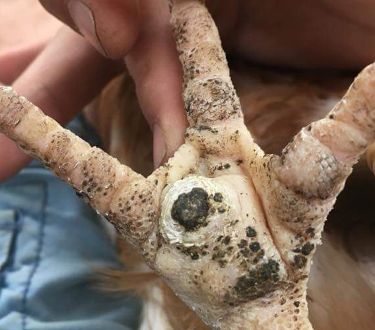
Scaly legs or raised scales is most likely the scaly Leg Mite.
Wings hanging down or brushing the ground. Heatstroke, injury, Mareks disease. Sometimes they do this to stabilise themselves if they have lost their balance.
Holding wings out to sides. The birds are too hot and need shade and fresh water.
Chicks:
Blood in droppings is likely to be Coccidiosis. Treatment is the same for chicks as adult birds - see above.
Lameness is splayed leg or genetic faults.
Huddled together means they are too cold so increase temperature a little.
Noisy chicks are cold, hungry or thirsty.
Panting or spread out at edges of brooder are too hot. Reduce temperature a little or enlarge brooding area.
Sudden causes of death:
There are only really 5 common causes of sudden death in chickens , heart attack, predator attack or shock, stroke or poisoning.
If you find many dead chickens in your flock in a short period of time then suspect Avian flu.
More on Sudden death in chickens and what to do afterwards.
